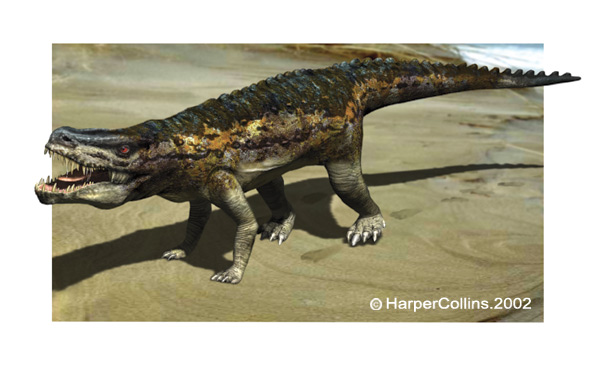
Postosuchus
December 20, 2007
Cryptomundo Exclusive
I am an American working in Liberia, West Africa with an international relief and development organization. I have always had a bit of an interest in cryptozoology, and enjoy your website.
Liberia is covered in dense rainforest and has a low population density. Because of its long civil war (now over), it has been almost totally neglected by biologists and other scientists.
In my work in northwestern Liberia I have been hearing reports about several animals which may be of interest to you. Most notable is a large amphibious reptile known as the “gbahali”.
It is described as being like a crocodile or monitor lizard, but much larger (up to 25 or 30 ft long). It has an armored back with three rows of serrations running down it, a powerful tail, and a short snout with many large teeth. It is known to be an ambush predator, carrying its prey underwater to drown before coming on shore to eat it.
I talked to a number of eyewitnesses who have seen this creature in recent years. I traveled to a village deep in the forest where fishermen used to actually catch these animals. They would use nets and shotguns to kill them, before butchering them and selling the meat in local markets. They told me that they used to have a skull of the animal in the village, but it was destroyed along with everything else when rebels set fire to the village. When I showed the villagers a picture of a Postosuchus taken off the internet, they all agreed that that is how the head and body of the gbahali looks, although the legs are semi-erect like a crocodile.

Postosuchus
The river in which these creatures are said to live is very remote, passing through large areas of unihabited forest. They are said to mainly be seen during the rainy season, when they travel upstream to look for food. They are greatly feared by the local population, because they have been known to kill people.
As recently as this November 2007, someone was attacked and killed by a large unknown animal near a village called Gelema, on that river. The United Nations police went to investigate, and found out that only the man’s head and a few body parts were left on the river bank. In this same village, the town meeting house was built according to the length of a gbahali that was killed there in years gone by.
I know this might sound sensational, like a bad monster movie or something. I have lived in Liberia and have heard my share of tall tales about dwarfs and jinns and so forth. However, there is nothing fantastic or supernatural in the accounts I have been hearing. To them this is just another kind of water animal, albeit a very large and dangerous one! I talked to at least three people in different villages who have had encounters with these animals. I have also heard about a picture that was taken in the last ten years of this creature as people were trying to capture it. I hope to spend some time in the coming year investigating these reports further.~ Sincerely, John-Mark Shephard, December 19, 2007.
About Loren Coleman
Loren Coleman is one of the world’s leading cryptozoologists, some say “the” leading living cryptozoologist. Certainly, he is acknowledged as the current living American researcher and writer who has most popularized cryptozoology in the late 20th and early 21st centuries.
Starting his fieldwork and investigations in 1960, after traveling and trekking extensively in pursuit of cryptozoological mysteries, Coleman began writing to share his experiences in 1969. An honorary member of Ivan T. Sanderson’s Society for the Investigation of the Unexplained in the 1970s, Coleman has been bestowed with similar honorary memberships of the North Idaho College Cryptozoology Club in 1983, and in subsequent years, that of the British Columbia Scientific Cryptozoology Club, CryptoSafari International, and other international organizations. He was also a Life Member and Benefactor of the International Society of Cryptozoology (now-defunct).
Loren Coleman’s daily blog, as a member of the Cryptomundo Team, served as an ongoing avenue of communication for the ever-growing body of cryptozoo news from 2005 through 2013. He returned as an infrequent contributor beginning Halloween week of 2015.
Coleman is the founder in 2003, and current director of the International Cryptozoology Museum in Portland, Maine.
Filed under Breaking News, Cryptomundo Exclusive, Cryptotourism, CryptoZoo News, Cryptozoologists, Cryptozoology, Eyewitness Accounts, Living Dinosaurs, Swamp Monsters